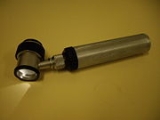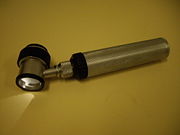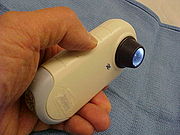
Dysplastic nevus
Encyclopedia
A dysplastic nevus is an atypical melanocytic nevus
; a mole whose appearance is different from that of common moles. Dysplastic nevi are generally larger than ordinary moles and have irregular and indistinct borders. Their color frequently is not uniform and ranges from pink to dark brown; they usually are flat, but parts may be raised above the skin surface. Dysplastic nevi can be found anywhere, but are most common on the trunk
in men, and on the calves
in women. In 1992, the NIH
recommended that the term "dysplastic nevus" be avoided in favor of the term "atypical mole."
, researchers have shown that atypical moles are more likely than ordinary moles to develop into a type of skin cancer
called melanoma
. It is worth noting that the vast majority of atypical moles will never become malignant. However, numerous studies indicate that about half of melanomas arise from atypical moles. Evidence supporting this connection arises from clinical photodocumentation of evolving lesions, patient self-reports of changing lesions, pathology studies showing dysplastic nevi in histologic contiguity with melanoma, and epidemiology studies indicating that about half of individuals affected by melanoma also have atypical moles. Epidemiology studies have also shown that individuals with multiple dysplastic nevi are at much higher risk for developing melanomas. Because of this, moles should be checked regularly by a doctor or nurse specialist, especially if they look complex; grow larger; or change in color, or shape; or if any changes occur, such as itching, flaking or oozing.

 Although there are limited data to support its efficacy, skin self-examination is frequently recommended for preventing melanoma (by identifying atypical moles that can be removed) or for early detection of existing tumors. Examination by a dermatologist has been shown to be beneficial for early melanoma detection. Some dermatologist recommend that an individual with either histologic diagnosis of dysplastic nevus, or clinically apparent atypical moles should be examined by an experienced dermatologist with dermatoscopy
Although there are limited data to support its efficacy, skin self-examination is frequently recommended for preventing melanoma (by identifying atypical moles that can be removed) or for early detection of existing tumors. Examination by a dermatologist has been shown to be beneficial for early melanoma detection. Some dermatologist recommend that an individual with either histologic diagnosis of dysplastic nevus, or clinically apparent atypical moles should be examined by an experienced dermatologist with dermatoscopy
once a year (or more frequently). mage:WB032021.JPG|thumb|230px|
The acronym ABCDE has been useful for helping health care providers and laypersons remember the key characteristics of a melanoma (see "ABCDE" mnemonic below) moles
Changes (in shape, size, color, itching or bleeding) should be brought to the attention of a dermatologist .
A popular method for remembering the signs and symptoms of melanoma is the mnemonic "ABCDE":
The E is sometimes omitted, as in the ABCD guideline. A weakness in this system is the D. Many melanomas present themselves as lesions smaller than 6 mm in diameter. An astute physician will examine all abnormal moles, including ones less than 6 mm in diameter. Unfortunately for the average person, many seborrheic keratosis
, some lentigo senilis, and even warts may have ABCD characteristics, and cannot be distinguished from a melanoma without a trained eye or dermatoscopy
.
A recent and novel method of melanoma detection is the "Ugly Duckling Sign" It is simple, easy to teach, and highly effective in detecting melanoma. Simply, correlation of common characteristics of a person's skin lesion is made. Lesions which greatly deviate from the common characteristics are labeled as an "Ugly Duckling", and a dermatologist exam is required. The "Little Red Riding Hood" sign, suggests that individuals with fair skin and light colored hair might prove more challenging. These fair skinned individuals often have lightly pigmented or amelanotic melanomas which will not present with easy to observe color changes and variation in colors. The borders of these amelanotic melanomas are often indistinct, making visual identification without a dermatoscope (dermatoscopy
) very difficult. A dermatoscope must be used to detect "ugly ducklings" among those with light skin or blonde/red hair.
People with a personal or family history of skin cancer or of dysplastic nevus syndrome
(multiple atypical moles) should see a dermatologist at least once a year to be sure they are not developing melanoma.
takes place in order to best diagnose it. Local anesthetic is used to numb the area, then the mole is biopsied. The biopsy material is then sent to a laboratory
to be evaluated by a pathologist. A skin biopsy
can be a punch, shave, or complete excision. The complete excision is the preferred method, but a punch biopsy can suffice if the patient has cosmetic concerns (i.e. the patient does not want a scar) and the lesion is small. A scoop or deep shave biopsy is often advocated, but should be avoided due to risk of a recurrent nevus, which can complicate future diagnosis of a melanoma, and the possibility that resulting scar tissue can obscure tumor depth if a melanoma is found to be present and re-excised.
Most dermatologists and dermatopathologists use a system devised by the NIH for classifying melanocytic lesions. In this classification, a nevus can be defined as benign, having atypia, or being a melanoma. A benign nevus is read as (or understood as) having no cytologic or architectural atypia. An atypical mole is read as having architectural atypia, and having (mild, moderate, or severe) cytologic (melanocytic) atypia. Usually, cytologic atypia is of more important clinical concern than architectural atypia. Usually, moderate to severe cytologic atypia will require further excision to make sure that the surgical margin is completely clear of the lesion.
The most important aspect of the biopsy report is that the pathologist indicates if the margin is clear (negative or free of melanocytic nevus), or if further tissue (a second surgery) is required. If this is not mentioned, usually a dermatologist or clinician will require further surgery if moderate to severe cytologic atypia is present - and if residual nevus is present at the surgical margin.
Roughly half of melanomas arise "de novo" on clear skin growth
, whereas the other half arise within atypical moles. Those with dysplastic nevi have an elevated risk of melanoma. Such persons need to be checked regularly for any changes in their moles and to note any new ones. In 40-50% of cases, the disorder has been linked with germline mutations in the CDKN2A
gene, which codes for p16
(a regulator of cell division).
Melanocytic nevus
A melanocytic nevus is a type of lesion that contains nevus cells .Some sources equate the term mole with "melanocytic nevus". Other sources reserve the term "mole" for other purposes....
; a mole whose appearance is different from that of common moles. Dysplastic nevi are generally larger than ordinary moles and have irregular and indistinct borders. Their color frequently is not uniform and ranges from pink to dark brown; they usually are flat, but parts may be raised above the skin surface. Dysplastic nevi can be found anywhere, but are most common on the trunk
Torso
Trunk or torso is an anatomical term for the central part of the many animal bodies from which extend the neck and limbs. The trunk includes the thorax and abdomen.-Major organs:...
in men, and on the calves
Calf (anatomy)
In human anatomy the calf is the back portion of the lower leg . In terms of muscle systems, the calf corresponds to the posterior compartment of the leg. Within the posterior compartment, the two largest muscles are known together as the calf muscle and attach to the heel via the Achilles tendon...
in women. In 1992, the NIH
National Institutes of Health
The National Institutes of Health are an agency of the United States Department of Health and Human Services and are the primary agency of the United States government responsible for biomedical and health-related research. Its science and engineering counterpart is the National Science Foundation...
recommended that the term "dysplastic nevus" be avoided in favor of the term "atypical mole."
Cancer
According to the National Cancer InstituteNational Cancer Institute
The National Cancer Institute is part of the National Institutes of Health , which is one of 11 agencies that are part of the U.S. Department of Health and Human Services. The NCI coordinates the U.S...
, researchers have shown that atypical moles are more likely than ordinary moles to develop into a type of skin cancer
Skin cancer
Skin neoplasms are skin growths with differing causes and varying degrees of malignancy. The three most common malignant skin cancers are basal cell cancer, squamous cell cancer, and melanoma, each of which is named after the type of skin cell from which it arises...
called melanoma
Melanoma
Melanoma is a malignant tumor of melanocytes. Melanocytes are cells that produce the dark pigment, melanin, which is responsible for the color of skin. They predominantly occur in skin, but are also found in other parts of the body, including the bowel and the eye...
. It is worth noting that the vast majority of atypical moles will never become malignant. However, numerous studies indicate that about half of melanomas arise from atypical moles. Evidence supporting this connection arises from clinical photodocumentation of evolving lesions, patient self-reports of changing lesions, pathology studies showing dysplastic nevi in histologic contiguity with melanoma, and epidemiology studies indicating that about half of individuals affected by melanoma also have atypical moles. Epidemiology studies have also shown that individuals with multiple dysplastic nevi are at much higher risk for developing melanomas. Because of this, moles should be checked regularly by a doctor or nurse specialist, especially if they look complex; grow larger; or change in color, or shape; or if any changes occur, such as itching, flaking or oozing.
Precaution for individuals with dysplastic nevi


Dermatoscopy
Dermatoscopy is the examination of skin lesions with a dermatoscope...
once a year (or more frequently). mage:WB032021.JPG|thumb|230px|
The acronym ABCDE has been useful for helping health care providers and laypersons remember the key characteristics of a melanoma (see "ABCDE" mnemonic below) moles
Melanocytic nevus
A melanocytic nevus is a type of lesion that contains nevus cells .Some sources equate the term mole with "melanocytic nevus". Other sources reserve the term "mole" for other purposes....
Changes (in shape, size, color, itching or bleeding) should be brought to the attention of a dermatologist .
A popular method for remembering the signs and symptoms of melanoma is the mnemonic "ABCDE":
- Asymmetrical skin lesion.
- Border of the lesion is irregular.
- Color: melanomas usually have multiple colors.
- Diameter: moles greater than 6 mm are more likely to be melanomas than smaller moles.
- Evolution: The evolution (ie change) of a mole or lesion may be a hint that the lesion is becoming malignant.
The E is sometimes omitted, as in the ABCD guideline. A weakness in this system is the D. Many melanomas present themselves as lesions smaller than 6 mm in diameter. An astute physician will examine all abnormal moles, including ones less than 6 mm in diameter. Unfortunately for the average person, many seborrheic keratosis
Seborrheic keratosis
A seborrheic keratosis is a noncancerous benign skin growth that originates in keratinocytes. Like liver spots, seborrheic keratoses are seen more often as people age. In fact they are sometimes humorously referred to as the "barnacles of old age". They appear in various colors, from light tan to...
, some lentigo senilis, and even warts may have ABCD characteristics, and cannot be distinguished from a melanoma without a trained eye or dermatoscopy
Dermatoscopy
Dermatoscopy is the examination of skin lesions with a dermatoscope...
.
A recent and novel method of melanoma detection is the "Ugly Duckling Sign" It is simple, easy to teach, and highly effective in detecting melanoma. Simply, correlation of common characteristics of a person's skin lesion is made. Lesions which greatly deviate from the common characteristics are labeled as an "Ugly Duckling", and a dermatologist exam is required. The "Little Red Riding Hood" sign, suggests that individuals with fair skin and light colored hair might prove more challenging. These fair skinned individuals often have lightly pigmented or amelanotic melanomas which will not present with easy to observe color changes and variation in colors. The borders of these amelanotic melanomas are often indistinct, making visual identification without a dermatoscope (dermatoscopy
Dermatoscopy
Dermatoscopy is the examination of skin lesions with a dermatoscope...
) very difficult. A dermatoscope must be used to detect "ugly ducklings" among those with light skin or blonde/red hair.
People with a personal or family history of skin cancer or of dysplastic nevus syndrome
Dysplastic nevus syndrome
Dysplastic nevus syndrome is a cutaneous condition described in certain families, and characterized by unusual nevi and multiple inherited melanomas.-Historical background:In 1820 Norris reported the first case of what is now recognized as FAMMM...
(multiple atypical moles) should see a dermatologist at least once a year to be sure they are not developing melanoma.
Biopsy
When an atypical mole has been identified, a skin biopsySkin biopsy
Skin biopsy is a biopsy technique in which a skin lesion is removed and sent to the pathologist to render a microscopic diagnosis. It is usually done under local anesthetic in a physician's office, and results are often available in 4 to 10 days. It is commonly performed by dermatologists. Skin...
takes place in order to best diagnose it. Local anesthetic is used to numb the area, then the mole is biopsied. The biopsy material is then sent to a laboratory
Laboratory
A laboratory is a facility that provides controlled conditions in which scientific research, experiments, and measurement may be performed. The title of laboratory is also used for certain other facilities where the processes or equipment used are similar to those in scientific laboratories...
to be evaluated by a pathologist. A skin biopsy
Skin biopsy
Skin biopsy is a biopsy technique in which a skin lesion is removed and sent to the pathologist to render a microscopic diagnosis. It is usually done under local anesthetic in a physician's office, and results are often available in 4 to 10 days. It is commonly performed by dermatologists. Skin...
can be a punch, shave, or complete excision. The complete excision is the preferred method, but a punch biopsy can suffice if the patient has cosmetic concerns (i.e. the patient does not want a scar) and the lesion is small. A scoop or deep shave biopsy is often advocated, but should be avoided due to risk of a recurrent nevus, which can complicate future diagnosis of a melanoma, and the possibility that resulting scar tissue can obscure tumor depth if a melanoma is found to be present and re-excised.
Most dermatologists and dermatopathologists use a system devised by the NIH for classifying melanocytic lesions. In this classification, a nevus can be defined as benign, having atypia, or being a melanoma. A benign nevus is read as (or understood as) having no cytologic or architectural atypia. An atypical mole is read as having architectural atypia, and having (mild, moderate, or severe) cytologic (melanocytic) atypia. Usually, cytologic atypia is of more important clinical concern than architectural atypia. Usually, moderate to severe cytologic atypia will require further excision to make sure that the surgical margin is completely clear of the lesion.
The most important aspect of the biopsy report is that the pathologist indicates if the margin is clear (negative or free of melanocytic nevus), or if further tissue (a second surgery) is required. If this is not mentioned, usually a dermatologist or clinician will require further surgery if moderate to severe cytologic atypia is present - and if residual nevus is present at the surgical margin.
Dysplastic nevus syndrome
"Dysplastic nevus syndrome" refers to individuals who have high numbers of benign moles and also have dysplastic nevi. A small percent of these individuals are members of melanoma kindreds. Inherited dysplastic nevus syndrome is an autosomal dominant hereditary condition. Dysplastic nevi are more likely to undergo malignant transformation when they occur among members of melanoma families. At least one study indicates a cumulative lifetime risk of nearly 100% in individuals who have dysplastic nevi and are members of melanoma kindreds. (ref needed)Roughly half of melanomas arise "de novo" on clear skin growth
Tumor
A tumor or tumour is commonly used as a synonym for a neoplasm that appears enlarged in size. Tumor is not synonymous with cancer...
, whereas the other half arise within atypical moles. Those with dysplastic nevi have an elevated risk of melanoma. Such persons need to be checked regularly for any changes in their moles and to note any new ones. In 40-50% of cases, the disorder has been linked with germline mutations in the CDKN2A
CDKN2A
CDKN2A can refer to:* P16 * p14arf...
gene, which codes for p16
P16
P16, P-16, or P.6 may refer to:* p16 , also known as p16Ink4A, a gene involved in tumor suppression* AMC Schneider P 16, a French halftrack developed in the 1920s...
(a regulator of cell division).
External links
See also
- NevusNevusNevus is the medical term for sharply-circumscribed and chronic lesions of the skin. These lesions are commonly named birthmarks and moles. Nevi are benign by definition...
- List of cutaneous conditions

